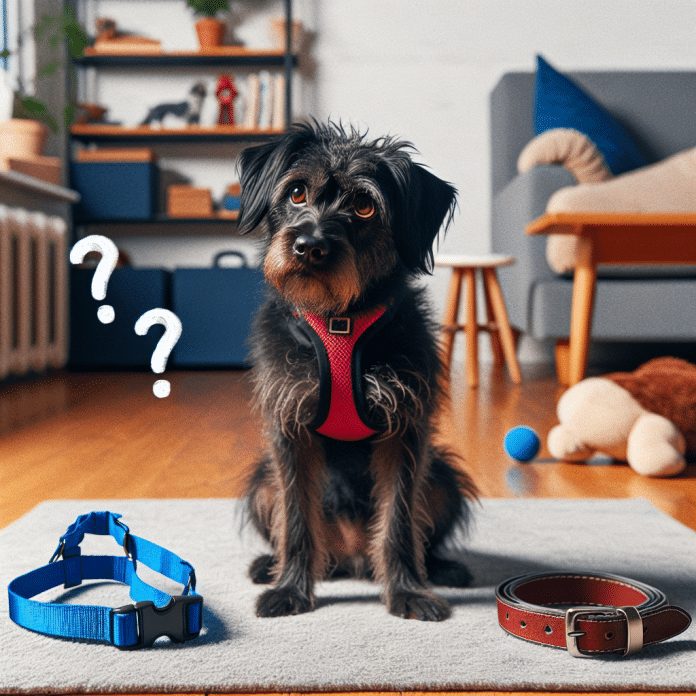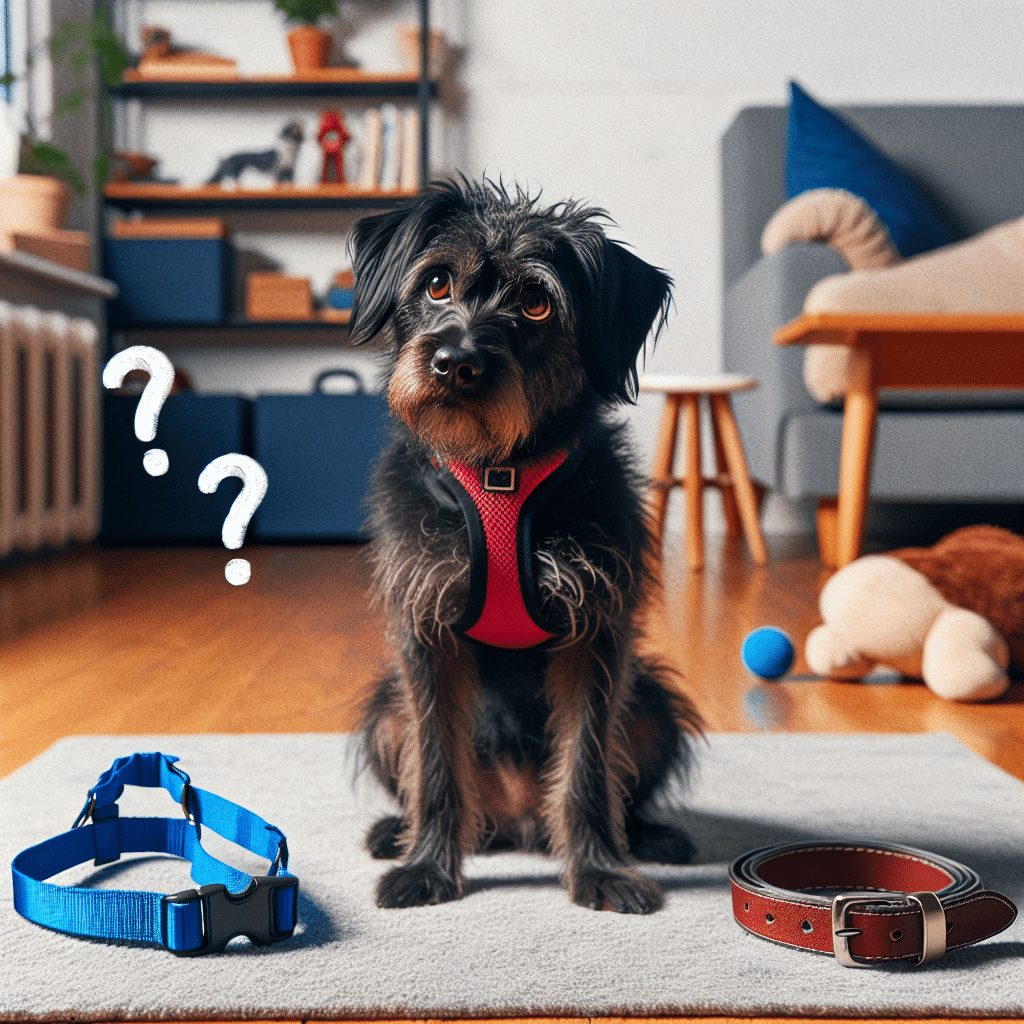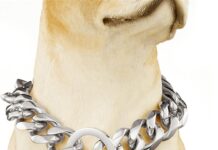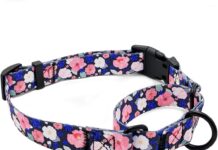Deciding whether to use a harness or collar for a reactive dog can be quite the dilemma. With the vast array of options available, it can be overwhelming to choose the right tool that will help you manage your dog’s reactive behavior effectively, while also keeping them safe and comfortable. In this article, we will explore the pros and cons of using both a harness and a collar, providing you with the information you need to make an informed decision that suits both you and your furry friend. So, without further ado, let’s delve into the world of harnesses and collars for reactive dogs and find the perfect fit for your canine companion.
Benefits of Using a Harness
Better Control and Stability
Using a harness provides you with greater control and stability over your dog. The design of a harness allows for distributed pressure and ensures that there is no strain on your dog’s neck or throat. This makes it easier for you to guide your dog and maintain control, especially in situations where they may be more reactive or prone to pulling.
Reduced Risk of Neck Injury
One of the major benefits of using a harness is that it greatly reduces the risk of neck injury for your dog. Dogs that tend to pull on their leash while wearing a collar can put strain on their neck and throat, which can lead to discomfort and potential injuries. With a harness, the pressure is evenly distributed across the dog’s chest and back, eliminating the risk of neck injuries.
Gentler on the Dog’s Body
Harnesses are known to be gentler on a dog’s body compared to collars. Since the pressure is spread out over a larger surface area, there is less strain and potential pain for your dog. This is especially important if your dog has any pre-existing neck or back issues or is prone to respiratory problems. A harness provides a more comfortable and safe option for them.
Distributed Pressure
One of the key advantages of using a harness is that it distributes the pressure evenly across your dog’s body. This helps to prevent any one area from bearing all the weight and strain, ensuring that your dog remains comfortable and free from discomfort. By avoiding concentrated pressure, a harness minimizes the risk of injury or discomfort during walks or other activities.
Prevents Escaping
Harnesses also offer the benefit of preventing your dog from easily escaping or slipping out of their leash. The snug fit of a harness around their body, combined with the multiple points of attachment, provides you with added security and peace of mind. This is especially important if your dog tends to be more reactive or has a strong prey drive, as it helps to ensure their safety during walks or outings.
Drawbacks of Using a Harness
Potential for Pulling
While a harness can provide better control and reduce pulling in some dogs, for others, it may actually encourage pulling. Some dogs, especially those with a strong prey drive or a tendency to be reactive, may find the harness more comfortable and may try to pull more. It is important to consider your individual dog’s behavior and tendencies before deciding on a harness.
Can Encourage Pulling in Some Dogs
In certain cases, using a harness may actually encourage pulling behavior in dogs. Some dogs may feel a sense of freedom or find it easier to exert their strength when wearing a harness. It is important to monitor your dog’s behavior closely and consider other training methods if you notice an increase in pulling or reactive behavior while using a harness.
May Restrict Natural Movement
Depending on the type of harness you choose, it may restrict your dog’s natural movement to some extent. While a properly fitted harness should not cause discomfort or restrict movement excessively, it’s important to ensure that your dog can still move their legs and shoulders freely. Opt for a harness design that provides a balance between control and comfort for your dog.
Difficult for Dogs with Certain Health Issues
Although a harness is generally a safe and comfortable option for most dogs, it may not be suitable for those with certain health issues. Dogs with respiratory problems, such as brachycephalic breeds, may find it challenging to breathe properly while wearing a harness. Additionally, dogs with back or spine issues may require specialized harnesses or alternative methods of control to avoid exacerbating their conditions.
Benefits of Using a Collar
Quick and Easy to Put On
Using a collar for your dog is quick and easy, making it a convenient option for everyday use. Collars generally have simple buckle or snap closures, allowing you to easily put them on and take them off your dog. This is especially beneficial for busy pet parents or those who frequently need to leash and unleash their dogs.
Can Be Used for Identification Tags
Collars provide a convenient place to attach identification tags for your dog. This is essential for ensuring their safety and quick identification if they ever become lost or separated from you. Having their personalized tags easily visible on their collar allows others to identify your dog and contact you promptly, increasing the chances of a speedy reunion.
Suitable for Dogs with No Neck or Back Issues
If your dog has no known neck or back issues, using a collar is a suitable option. The simplicity of a collar makes it a practical choice for dogs without any specific physical concerns. As long as the collar is properly fitted and comfortable, it can serve as an effective tool for control during walks or other activities.
More Control over the Dog’s Head
Using a collar provides you with more control over your dog’s head, which can be advantageous during obedience training or when dealing with reactive behavior. By attaching the leash to a collar, you have direct control over your dog’s movements and can easily guide their head and neck in the desired direction. This can help to establish clear boundaries and reinforce desired behaviors.
Drawbacks of Using a Collar
Risk of Neck or Throat Injuries
One of the main drawbacks of using a collar is the potential risk of neck or throat injuries. Dogs that pull or lunge while wearing a collar can strain their necks and throats, leading to discomfort and potential injuries such as bruising, tracheal damage, or even collapsed tracheas. It is important to carefully monitor your dog’s behavior and consult a professional if you notice any signs of distress or injury.
May Cause Tracheal Collapse
Certain dog breeds, particularly those with short muzzles or flat faces, are more prone to tracheal collapse. Using a collar puts additional pressure on their already compromised airways, increasing the risk of this serious condition. If you have a brachycephalic breed or a dog with any respiratory issues, it is recommended to avoid using a collar and opt for a harness instead.
Less Stability and Control
Compared to a harness, using a collar provides less stability and control over your dog. With the leash attached to the neck, there is a higher chance of your dog slipping out of their collar, especially if they tend to be reactive or have a strong prey drive. This reduced stability can make walks or outings more challenging and potentially create safety risks.
Potential for Escaping
Collars may present a higher risk of escape for some dogs, particularly those skilled at slipping out of their collar or harness. A determined dog may be able to back out of a collar, especially if it is not properly fitted or if they have a slender neck. This can be dangerous, as they may run off or get into potentially hazardous situations. It is important to choose a secure and well-fitted collar to minimize the risk of escaping.
Considerations Before Choosing
Reactivity Level of the Dog
Before deciding whether to use a harness or collar, consider the reactivity level of your dog. If your dog tends to be reactive or easily distracted, a harness may provide better control and minimize pulling. However, if your dog is well-behaved and responds reliably to commands, a collar may be sufficient for your needs.
Training Methods Used
The training methods you use to teach your dog appropriate leash manners can also play a role in your decision. Positive reinforcement training methods that focus on rewarding desired behaviors may be more effective with a harness, as it offers better control and reduces the risk of injury. However, if you have successfully trained your dog to walk politely on a collar, it may be a suitable option.
Health and Physical Condition of the Dog
Take into consideration the overall health and physical condition of your dog. If your dog has a health issue, such as respiratory problems or a history of neck or back injuries, a harness may be the safer choice. Consult with your veterinarian to determine the best option for your dog’s specific needs.
Behavioral Issues
If your dog displays any behavioral issues, such as aggression or fearfulness, it is important to consult with a professional before choosing between a harness or collar. They will assess your dog’s behavior and create a tailored plan to address their specific needs. In some cases, a harness may be recommended to provide better control and minimize the risk of injury during training or behavior modification.
Type and Size of Dog
Consider the type and size of your dog when deciding between a harness or collar. Certain breeds, such as brachycephalic breeds or those with elongated necks, may be more prone to injuries or discomfort with a collar. Large dogs with a tendency to pull may benefit from the additional control and stability provided by a harness.
Types of Harnesses
Back-Clip Harness
A back-clip harness features a D-ring attachment on the back of the dog’s body, to which the leash is attached. This type of harness is commonly used for small and medium-sized dogs. It distributes pressure across the shoulders and chest, allowing for greater control while minimizing strain on the neck.
Front-Clip Harness
A front-clip harness has a D-ring attachment located on the front of the dog’s body, typically at the center of their chest. This design helps to redirect the dog’s forward motion when they pull, encouraging them to turn towards you instead. Front-clip harnesses are particularly effective in reducing pulling behavior and providing control over dogs with a tendency to react to stimuli.
Head Halter
A head halter is a type of harness that fits around the dog’s muzzle and neck, similar to a horse’s halter. The leash attaches to a ring under the dog’s chin, giving you more control over their head while walking. Head halters are particularly useful for dogs with pulling or reactive behaviors, as they provide redirecting control without causing discomfort or pain.
Tightening Harness
A tightening harness, also known as a no-pull or anti-pull harness, is designed to tighten around the dog’s body when they pull on their leash. This creates a sensation that discourages pulling and redirects the dog’s attention to walking calmly by your side. Tightening harnesses can be effective for dogs that have a strong pulling instinct, but it is important to use them correctly and responsibly to avoid causing discomfort or anxiety.
Choosing the Right Harness
Size and Fit
To ensure the harness provides maximum benefit and comfort for your dog, it is crucial to choose the right size and ensure a proper fit. Measure your dog’s girth, around their chest just behind the front legs, and refer to the manufacturer’s sizing chart. A harness should fit snugly but allow enough room for your dog to move comfortably. Adjustability is also important to accommodate your dog’s growth and ensure a secure fit.
Comfort for the Dog
Consider the comfort of the harness for your dog. Look for materials that are soft, breathable, and non-abrasive to minimize the risk of chafing or irritation. Check for any potential pressure points or rough edges that may cause discomfort. A comfortable harness will encourage your dog to accept and enjoy wearing it, making walks and outings more enjoyable for both of you.
Adjustability
Choose a harness with adjustable straps to ensure a proper fit for your dog. Adjustable straps allow you to customize the harness to your dog’s unique body shape and size. This is especially important for young dogs that are still growing or if you have multiple dogs of different sizes.
Durability
Select a harness made from durable materials that can withstand your dog’s activity level. Look for strong stitches, reinforced attachment points, and high-quality hardware. A durable harness will last longer and provide consistent support and control for your dog during walks or other activities.
Reflective Features
Consider a harness with reflective features, such as reflective stitching or strips. This enhances your dog’s visibility during low-light conditions, making walks safer, especially in the early morning or evening. Reflective harnesses can also be beneficial if you plan on walking in areas with heavy traffic or low visibility.
Types of Collars
Flat Collar
The flat collar is the most common and basic type of collar. It consists of a simple strip of material with a buckle or snap closure. Flat collars are widely available in various materials, designs, and sizes to suit different dogs. They offer a lightweight and straightforward option for everyday use.
Martingale Collar
A martingale collar, also known as a limited-slip collar, is designed to provide gentle control without choking or strangling the dog. It consists of a flat collar with an additional loop that tightens when the dog pulls, helping to prevent them from slipping out of the collar. Martingale collars are particularly useful for dogs with narrow heads or those prone to slipping out of traditional collars.
Head Collar
A head collar, similar to a halter for horses, fits around the dog’s muzzle and neck and allows control over their head movements. It typically has a strap that attaches under the dog’s chin and another that goes around the back of their head. Head collars provide effective control and can help redirect pulling behavior, making them suitable for dogs that require extra control during walks.
Prong Collar
A prong collar, also known as a pinch collar, consists of linked metal prongs that sit snugly around the dog’s neck. When the leash is pulled, the prongs gently pinch the dog’s skin, mimicking the correction provided by a mother dog. Prong collars are controversial and should only be used under the guidance of a professional trainer who is experienced in their proper use.
Choosing the Right Collar
Size and Fit
When choosing a collar for your dog, it is crucial to select the right size and ensure a proper fit. Measure your dog’s neck circumference and refer to the manufacturer’s sizing guide. A properly fitted collar should allow you to slide two fingers between the collar and your dog’s neck. This ensures a secure fit without being too tight or loose, preventing discomfort or the risk of escape.
Material and Durability
Consider the material and durability of the collar. Opt for a high-quality material that is sturdy and able to withstand your dog’s activity level. Collars made from nylon, leather, or durable fabrics are popular choices. Check for reinforced stitching and sturdy hardware to ensure the collar’s longevity.
Training Purpose
Consider the purpose of the collar in your dog’s training. Different collars offer varying levels of control and can be suited for different training methods. For example, a head collar can provide better control for dogs that tend to pull, while a martingale collar is useful for dogs that have a tendency to slip out of traditional flat collars.
Comfort for the Dog
Ensure that the collar you choose is comfortable for your dog, especially if they will be wearing it for extended periods. Look for materials that are soft and non-irritating to minimize discomfort or chafing. Avoid collars with rough edges, particularly if your dog has sensitive skin or allergies.
Safety Features
Safety features should also be considered when choosing a collar. Look for collars with reflective stitching or strips to enhance your dog’s visibility during low-light conditions. Additionally, quick-release or breakaway buckles are beneficial for added safety, especially if your dog may get caught on objects or could become tangled.
Consulting a Professional
Dog Trainer
If you are unsure about which option is best for your dog, consulting a professional dog trainer can provide valuable guidance. A trainer will assess your dog’s behavior, individual needs, and training goals to recommend the most suitable option. A trainer can also guide you on proper fitting and usage to ensure the chosen equipment is effective and safe.
Veterinarian
Prior to deciding between a harness or collar, it is recommended to consult with your veterinarian, especially if your dog has any pre-existing health conditions or physical limitations. They can provide insights into any potential concerns or complications that may arise from using one option over the other. Your veterinarian will be able to offer personalized advice based on your dog’s specific needs.
Behaviorist
If your dog has specific behavioral issues, such as reactivity or aggression, consulting a certified behaviorist can be beneficial. Behaviorists are trained to assess and address complex behavioral problems and can recommend appropriate training equipment based on your dog’s specific behavior and needs.
Physical Therapist
If your dog has any existing neck or back issues, it may be beneficial to consult a physical therapist or rehabilitation specialist. They can assess your dog’s condition and recommend appropriate equipment, such as a specialized harness or collar, to support their specific needs during walks or activities. Physical therapists can also provide additional exercises and therapies to help improve your dog’s mobility and overall well-being.
In conclusion, choosing between a harness or collar depends on various factors such as your dog’s behavior, health, and individual needs. Both options have their benefits and drawbacks, and it is essential to consider your dog’s comfort, safety, and training goals when making this decision. Consulting with a professional, such as a dog trainer, veterinarian, behaviorist, or physical therapist, can provide valuable guidance in determining the most suitable option for your dog. Selecting the right harness or collar, ensuring a proper fit, and using appropriate training methods will help create a safe and enjoyable walking experience for both you and your furry companion.









































